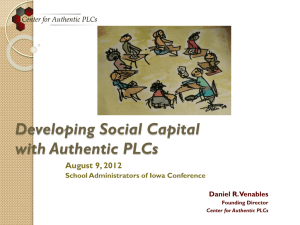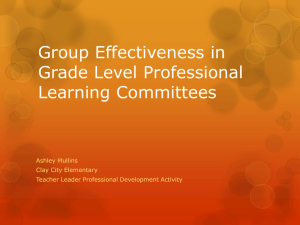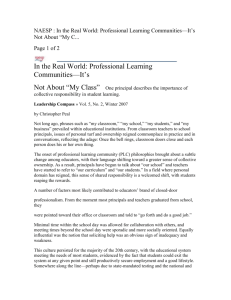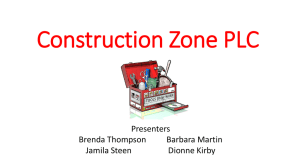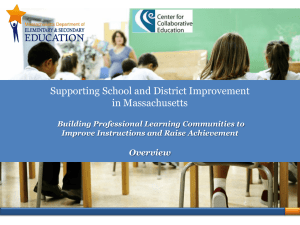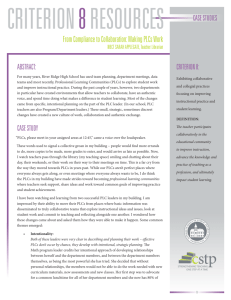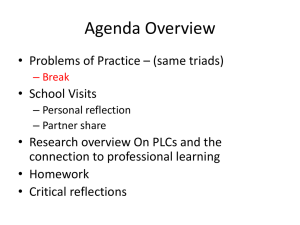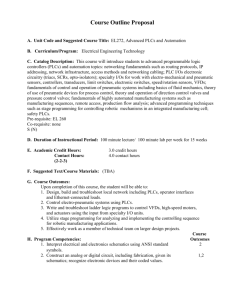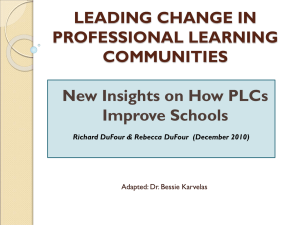Leadership Academy Presentation
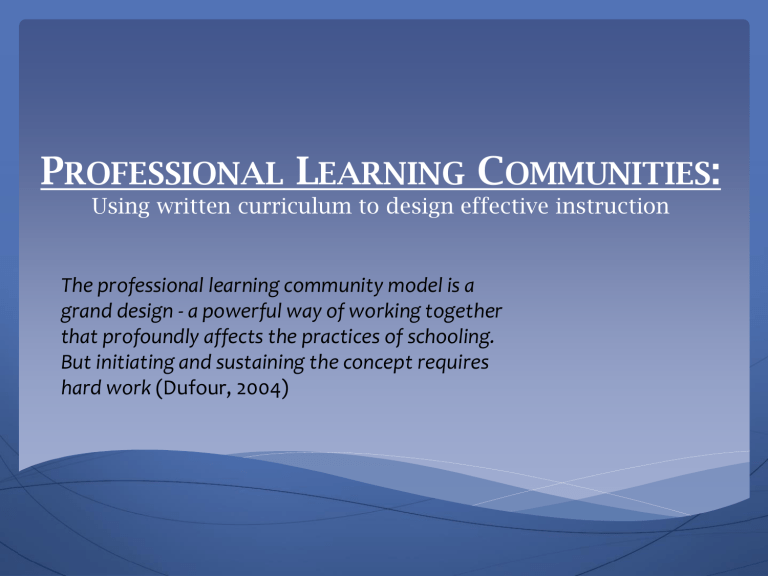
P ROFESSIONAL L EARNING C OMMUNITIES :
Using written curriculum to design effective instruction
The professional learning community model is a grand design - a powerful way of working together that profoundly affects the practices of schooling.
But initiating and sustaining the concept requires
hard work (Dufour, 2004)
Recasting PLC’s
“Create and maintain an environment that fosters collaboration, honest talk, and a commitment to the growth and development of individual members and to the group as a whole” (Lieberman and Miller, 2011)
Key conditions are: norms of collaboration; focus on students and their academic performance; access to a wide range of learning resources for individuals and the group; mutual accountability for student growth and success (Talbert, 2010)
“An inclusive group of people, motivated by a shared vision, who support and work with each other, finding ways, inside and outside their immediate community, to enquire on their practice and together learn new and better approaches that will enhance all pupils’ learning” (Stoll and Louis, 2010)
PLCs and Teacher Improvement
Teacher
A
90%
Proficient
Teacher
B
85%
Proficient
Teacher
C
53%
Proficient
Teacher
D
55%
Proficient
Growth =
+ 0.458
Growth =
+ 0.239
Growth =
- 0.206
Growth =
- 0.198
PLCs and School Improvement
Teacher
Collaboration
Increased
Student
Learning
Discussion of
Instruction
Instructional
Improvement
Horn & Little, 2010
PLCs and Written Curriculum
“Merely creating small structures for PLCs does not lead to changes in instructional practice” (Christman and
Supovitz, 2005)
Curriculum Documents Unpacked
• Stage 1:
• Standards Unpacked, Essential Questions, Enduring Understandings
• Stage 2:
• Exemplar Assessments (Formative and Summative)
• Stage 3:
• Learning Plan
• Aligned Resources
Stage 2 & 3 are still under development. They will be added as our writing teams complete the work. m
CCS Curriculum Documents
m
Written Curriculum
Guaranteed
Coherent Viable
Curriculum
UbD
Stage 1:
Desired Results
Stage 2:
Determining Acceptable
Evidence
Connection
PLC
What will students know, understand, and be able to do?
How will we know they are learning it?
Stage 3:
The Learning Plan
What teaching and learning experiences we will provide?
What will we do when students already know it?
What will we do if they don’t learn it?
(includes Enrich,
Remediate, and Reflect) What teaching and learning experiences were effective? How do we know?
PLC Framework m
What does this look like?
The Work and Learning of PLCs
Collaboration
Shared Insight Experimentation
Reflective Inquiry
If this is what we want, how do we get there?
Structural changes
Committee
Compliance
Documents
Roles and Responsibilities
Facilitators
Facilitators Guide
Compliance
District
School
Feedback on Units
(Google Doc)
CFA Assessments
Resource Sharing
(Google Doc)
Agendas/Minutes
Performance Rubric
(October and May)
Data Analysis Document
Coaching & Support
Administration
• Leadership
Academy
Facilitators
• August Webinar
• August Webinar
• Regular Follow up with
Instructional
Specialist
• Monthly School
Administrator
Meetings
All Teachers
• Introduction via
Planning Period
PD in August &
September
PLCs in Crisis
• Triangulated
Data Analysis
(Student data,
CWT, Principal input)
• Tiered,
Intensive
Coaching via
Instructional
Specialists j
Training for PLC Facilitators
• Webinars during the week of August 19
• August 22: 9:00am to 11:00am
• August 22: 2:00pm to 4:00pm
• August 23: 9:00am to 11:00am
• August 23: 2:00pm to 4:00pm m
What’s Next
PLC Facilitator’s framework
m
The framework…
IS DESIGNED TO…
• help facilitate conversations among
PLCs.
• help guarantee PLCs are talking about the “right” things.
• help administrators guide
PLC conversations.
• help troubleshoot curricular conversations.
• help measure the health of PLCs.
IS NOT DESIGNED TO…
• be a checklist PLCs must complete.
• dictate every topic of conversation a PLC has.
• be handed to teachers without a trained facilitator.
m
Additional training on the framework and process
• August Administrator meetings
• Principal
• Assistant Principal for Instruction
• Assistant Principal
• Facilitator Training during the week of August 19
• All administrators
• All facilitators
• Any interested teachers m
Roles and Responsibilities
This recasting of PLCs requires a redefinition of various roles and responsibilities:
Administrators
Facilitators
Teachers c
Compliance Measures
District:
(1) Provide feedback on every unit via Google Doc
(2) Suggest resources for each unit via Google Doc
(3) Complete the PLC Performance Rubric (Oct/May)
School:
(1) Agendas/Minutes
(2) Data Analysis Document
(3) School Administrator provides feedback on at least 1 CFA per PLC b
Next Steps
In the next session, Michael will present the materials you will use to train your PLCs for the first week’s work.
In addition, you will have time to prepare a plan for this professional development.
j

